




All throughout the week leading to the national protest held in Valletta on 27 May, my stomach must have been a stomping ground for mischievous butterflies. I’m sure I annoyed our CEO Mark Sultana more than usual with all the calls and messages. Come Friday evening we had done all we could. And by we I mean all the environmental NGOs that worked tirelessly on this.
At 9am on Saturday I was in Valletta at the Triton Fountain, our rallying spot. It was deserted so I headed to a coffee shop to while away the time and meet up with Mark. Walking back past the law courts, we met an army of Moviment Graffitti volunteers busy setting up stage and all. Back at Triton Fountain we met some BirdLife Malta volunteers. Slowly, more joined our group and flocked under our banner. More people turned up, with placards and banners.
The protest started moving, with drummers banging and people chanting. At one point I looked back and realised the size of the crowd: there were thousands! So many, that as the vanguard reached Castille, Triq Girolamo Cassar was still full of people! Why am I writing all this? For those who remember us being called erbat iqtates, you’d forgive my fear that only a handful would turn up. Seeing the size of that crowd chanting
“Xebbajtuna!” shows how far the environmental movement has come. It seems those four alley cats have grown to a sizeable colony! And it stands to reason.
People are disillusioned with the political class, so it’s no surprise that they place their trust in the environmental movement that has always been consistent.
The Xebbajtuna! call cannot and will not end at the protest. Rather, I believe it marks the start. It shows the strength of a unified environmental movement, with BirdLife Malta, Moviment Graffitti, Flimkien għal Ambjent Aħjar, Ramblers Assocation of Malta, Nature Trust-FEE Malta, Friends of the Earth Malta, Din l-Art Ħelwa and Għawdix working together, pooling our strengths and resources for a common cause. Our movement has also drawn the support of many other organisations and individuals who feel the social and environmental injustices taking place.
Now more than ever, it’s the time to support the movement against the forces of greed that are gorging and banqueting in the palaces of power. Let your voice be heard with ours: “XEBBAJTUNA!”
Darryl Grima President
The culprits in this list were all brought to justice after being observed and reported by BirdLife Malta teams.
Apr 2023. Trapper fined €1,000 + 2yr trapping licence suspension.
CRIME: Finch trapping on an unregistered site (Żonqor, Nov 2021).
Apr 2023. Trapper fined €1,300 + 2yr trapping licence suspension.
CRIME: Finch trapping on an unregistered site (St Paul’s Bay, Nov 2021).
Apr 2023. Trapper fined €1,000 + 2yr trapping licence suspension.
CRIME: Finch trapping on an unregistered site (Bengħajsa, Nov 2022).
Contact BirdLife Malta
mailing address: 57/28 Abate Rigord Street, Ta’ Xbiex XBX 1120, Malta tel: +356 21347645 • email: info@birdlifemalta.org • website: www.birdlifemalta.org
May 2023. Trapper fined €1,500 + 2yr trapping licence suspension.
CRIME: Finch trapping on an unregistered site (St Thomas Bay, Nov 2022).
May 2023. Trapper fined €1,000 + 2yr trapping licence suspension.
CRIME: Finch trapping on an unregistered site (Magħtab, Nov 2022).
May 2023. Trapper fined €1,200 + 2yr trapping licence suspension.
CRIME: Finch trapping on an unregistered site (Mtaħleb, Nov 2022).
May 2023. Trapper fined €1,200 + 2yr trapping licence suspension. CRIME: Finch trapping on an unregistered site (Luqa, Nov 2022).
Editorial Board Nathaniel Attard (Editor), Victor Falzon (Naturalist & Field Teacher), Antoine Monnier (Communication Assistant), Cinzia Mintoff (Graphic Design & Digital Media Communication Officer), Murat Gelir (Photography & Film Production Assistant), Nastasya Koroleva (Events & Outreach Assistant)
BirdLife Malta Council Darryl Grima (President), Caldon Mercieca (Vice-President), Norman Chetcuti (Treasurer), Denise Casolani (Council Secretary), James Aquilina, Kathleen Galea, Eurydike Kovacs, Paul Portelli, Raphael Soler, Steve Zammit Lupi (members)
Senior Management Team Mark Sultana (CEO), Nicholas Barbara (Head of Conservation), Mark Gauci (Head of Land Management), Stefania Papadopol (Education Manager), Nathaniel Attard (Communication Manager), Claudio Agius (Finance Manager), Manuel Mallia (Salina Park Manager), Manya Russo (LIFE PanPuffinus! Project Manager), Janet Borg (Office Coordinator)
Design Cinzia Mintoff
Printing Poulton’s Print
Front cover photo Eurasian Tree Sparrows by Aron Tanti
Reg. Vol. Org. VO/0052 © 2023 BirdLife Malta. All rights reserved.
On 27 May, thousands of people gathered in Valletta to express their strong disapproval of the current environmental situation. The protest, organised by several ENGOs including BirdLife Malta, began at Triton Fountain and walked to Castille, then moved through Republic Street, concluding in front of the Court. Throughout the event, six speakers addressed the crowd: Marsaskala resident Jacqueline Rotin, Qala mayor Paul Buttigieg, BirdLife Malta CEO Mark Sultana, Gżira mayor Conrad Borg Manché, Astrid Vella from Flimkien għal Ambjent Aħjar, and André Callus from Moviment Graffitti. We extend our gratitude to the thousands of Maltese and Gozitans who responded to the call and joined us to raise their concerns and to demand immediate changes in environmental practices and planning.



Despite multiple warnings from the EU, the Maltese Government has permitted hunting for European Turtle-dove again this spring. The hunting season for Quail opened on 10 April and for Turtle-dove on 17 April. The legal notice was published shortly after the Maltese Courts ruled against BirdLife Malta's request for a warrant of prohibitory injunction to halt the Turtle-dove hunt. Initially upheld on 3 April, Judge Giovanni Grixti later rejected the warrant and revoked the initial decision, allowing the government to open the season. Before the legal hunting period, numerous Turtle-doves had already been killed. At a press conference, BirdLife Malta officials displayed a dead Turtledove found in Delimara, and expressed disappointment with the Court's decision, which had relied solely on the WBRU's reports using scientific data up to 2018, conveniently ignoring later data which indicated further decline in Turtle-dove population.
Despite efforts to prevent it, the spring hunting season in Malta was allowed again this year, including on the European Turtledove, a Vulnerable species. International volunteers joined our Spring Watch camp to monitor spring bird migration and illegal hunting. The teams observed a high level of hunting activity targeting migratory birds, especially European Turtle-doves during the first part of the season when this was illegal, with reports of illegal electronic callers, modified shotguns, and hunting within 200m of residential areas. Several injured birds were rescued. It has become shameless custom that hunters declare shot Turtle-doves in the very last days and hours of the season. In this way they reach the national bag limit of 1,500 birds at the last hour of the season, after which the Wild Birds Regulation Unit (WBRU) farcically declares the season closed, conveniently just when it would have closed anyway.

On 31 March 2023, BirdLife Malta reported a flock of White Storks targeted by hunters while roosting overnight in Ħaż-Żabbar and Marsaskala. The storks, attracting numerous onlookers, were resting in an area called Wied iż-Żiju along the Marsaskala bypass. Initially, Environmental Protection Unit (EPU) officers and BirdLife Malta volunteers monitored the situation. The EPU later left to check on another flock, leaving the volunteers to continue watching. At around 9.30pm three shots were fired near the storks from two locations, causing them to scatter from one roost site. BirdLife Malta promptly alerted the police, who dispatched a second team to assist in locating suspects. A witness reported two suspicious individuals near the scene, leading to their apprehension by the Rapid Intervention Unit. BirdLife Malta volunteers kept watch throughout the night near the sleeping storks. By 9am the next day, only 33 of the initial 50 storks were accounted for. The highly protected birds seemed to have dispersed into smaller roosts, with two separate flocks of six and 13 birds observed taking off, later joined by another 14.


According to environmental scientist Dr John Paul Cauchi, the proposed development on Kemmuna will have an impact on the island’s landscape, and "the only way this proposed project could have been sustainable was by not building it". Using Hili Group’s own figures and architectural plans, Cauchi illustrated how the development will destroy the island’s peaceful natural landscape. He was speaking during a joint counter-exhibition staged by seven environmental organisations, including BirdLife Malta, outside the Mediterranean Conference Centre in Valletta, in response to Hili Group’s presentation of their plans to redevelop the old Comino Hotel site and a complex of villas in Santa Marija Bay.

BirdLife Malta is urging the government to introduce regulations to address the negative impact of light emissions and shipping activity on the breeding habits of nocturnal seabirds, as highlighted in a study published in the Journal of Ornithology. The study emphasises the vulnerability of Yelkouan Shearwaters, whose breeding patterns are significantly affected. These seabirds rely on deep burrows and caves in limestone cliffs for nesting. With 10% of the global Yelkouan population nesting in Malta, we have a special responsibility to ensure the protection of these birds’ nesting sites. Preserving their breeding habitat is crucial for the survival of the species. Research findings reveal that nocturnal seabirds exhibit reduced activity and avoid areas with intense natural or artificial light. Light pollution caused by human activity, especially shipping, is known to have led to site desertion. Direct illumination from ships lights up the cliff faces, resulting in significant decline in colony occupancy. The study recommends the introduction of regulations that address this threat in affected colonies.
In a significant blow to nature conservation, the European Parliament's Committee on Agriculture and Rural Development and the Fisheries Committee have voted against the proposed Nature Restoration law. This decision has sparked serious concerns, as it disregards scientific evidence and jeopardises our future. The onus now falls on the MEPs in the Committee on the Environment, Public Health and Food Safety to support a strong EU Nature Restoration law. Failure to do so would disappoint citizens across Europe who are calling for decisive action. Thankfully, there is still hope. We have a unique chance to reverse the decline of Europe's nature by implementing a law that would legally mandate EU countries to restore a specific amount of nature. This law would hold governments accountable and allow for legal action if they fail to meet their obligations. Along with over 200 NGOs BirdLife Malta is calling on concerned citizens to join us in demanding urgent approval and robust implementation of an EU Nature Restoration Law. Visit https://birdlifemalta.org/restorenature to show your concern.


Due to its overall resemblance to the much commoner Spanish Sparrow (Għasfur tal-Bejt), the Eurasian Tree Sparrow is probably one of the most overlooked birds that keep us company throughout the year. It is an attractive passerine with both sexes having a similar plumage, unlike the Spanish Sparrow where the sexes are evidently distinct. At first glance, Tree Sparrows look similar to the male Spanish Sparrow, but a closer look would show a number of differences, perhaps the most evident being the black patch on its pure white cheeks. The young birds have similar, yet duller, plumage to that of their parents.
The Tree Sparrow’s diet consists mainly of seeds, but invertebrates are not discarded whenever the chance crops up.
Despite the name, Tree Sparrows nest in cavities in rural buildings. When the breeding season approaches, a flurry of busy activity kicks off in a Tree Sparrow colony. Pairs form up, followed by nest construction and egg laying. After around two weeks of relative calm, waiting for the five or so eggs to hatch, a hectic period of around 20 days follows, with the coming and going of parent birds carrying food in their beak to satisfy the ever-hungry hatchlings. Parenthood is a challenging venture, even for a Tree Sparrow!

Although Tree Sparrows nest in buildings, they are not fond of urban areas, hence more urbanisation will cause this species problems to find adequate breeding habitat. Urban sprawl, certain agricultural practices, human disturbance, and competition with the Spanish Sparrow, are only some of a long list of hurdles this species must handle to survive in our densely populated archipelago. If we are not careful we will undermine this species, as we have already done with other farmland birds, such as the Corn Bunting, a once common species that has been practically wiped out from our islands.
Pointing fingers when it is too late will not help; acting while still in time is surely a much better option.
WORDS Aron Tanti BirdLife Malta nature photographer
MALTESE NAME: Ġaħġaħ
SCIENTIFIC NAME: Passer montanus
LENGTH: 12–14cm
WING SPAN: 20–22cm
CONSERVATION STATUS: Least Concern
LOCAL STATUS: Breeding resident
CALL: A chip call, higher in pitch and more melodious than the Spanish Sparrow’s, with a characteristic chweep flight call, from which its Maltese name derives.
BEHAVIOUR: Usually gregarious
HABITAT: Rural areas
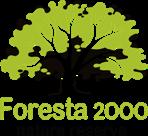
Opening hours Open all year round and accessible 24 hours a day
Entrance free (donations welcome!)
More info at http://bit.ly/Foresta2000NatureReserve


Many older people agree that butterflies were more common “when we were young". Well, we zap their young with pesticides, kill their foodplants with herbicide, and bury their habitat under concrete and tarmac, so it’s no surprise. Naturally, none of this happens at our nature reserves, so we often spot several of our twenty-odd species flitting along the footpaths and wild flowers at Foresta. One such beauty is the small and delicate Bath White. It’s largely white, with black spots on its upper wings and extensive greenish patterns on its lower wings. Its Maltese name refers to its foodplant, that vital species on which the mother lays her eggs for her young to gorge on. In the Bath White’s case it is various species of rockets and mustards.

Bużbież il-Qamħ Ridolfia segetum
It does look very much like the real Bużbieża (Fennel), down to its fine feathery foliage. But one give-away is that the False Fennel flowers a month or two earlier than its summer-loving cousin. It’s also much less common than Fennel, so it is encouraging that in recent years we have been spotting a few nice stands of this eye-catching shrub at Foresta too. It’s good news for biodiversity too because the False Fennel is a member of the carrot family, the members of which attract many bugs, beetles, bees, butterflies and hover-flies. These insects love nothing better than to land on the umbrella-like bouquets to guzzle pollen and nectar from a myriad yellow florets.


Daqquqa tat-Toppu Upupa epops
The Common Hoopoe is one of our more exotic-looking birds. In flight it’s like the bird version of a butterfly, with wide wings, flashing black-and-white stripes and a flappy flight. But once it settles on the ground it virtually disappears. How does it do it? Well, hoopoes have short legs, which gives them a low profile as they skulk and probe the soil for worms and insects with their long curved bill. Stripey wings apart, the bird’s body plumage is sandy, which helps the bird blend with the ground; as long, that is, as it doesn’t unfurl its pièce de résistance: that magnificent crest! Hoopoes are migratory birds, nesting in Europe and wintering in Africa. On their way to and fro, a few often land for a snack ’n’ snooze in the quiet glades at Foresta.
As the scholastic year draws to a close, Dinja Waħda Gardens are blossoming. From four active school wildlife gardens last scholastic year, nine are now set to connect school children with nature, with a tenth lined up after summer infrastructure works. Exactly what happens when a Dinja Waħda Garden is born?
Athe basis of our school gardens scheme are the watchful eyes of our Education Team, who keep a lookout for opportunities to connect children with nature on their school grounds by creating habitats for nature. These opportunities sometimes come in as requests from the school itself, but this year’s growth came from a different source. It was an Erasmus+ project output that allowed BirdLife to team up with the Institue of Earth Systems to carry out a survey of all primary school grounds, identifying green spaces and potential for Dinja Waħda Gardens.
Schools whose maps showed green spaces were invited to join the Dinja Waħda Gardens family as part of the same
programme to connect children with nature. Once a school confirms willingness to start on the Dinja Waħda Garden journey, the planning process kicks off. This involves a number of stages, from initial visit and production of existing vegetation plan, to discussions with administration and with staff and production of final draft plan. The final, crucial stage involves staff training for the educational journey of understanding,

discussing, planning, tweaking and eventual planting with their students. These stages are led by Education Team field teachers who are also designer/staff trainers.
A light level of maintenance is carried out by students with their teachers, however due to lack of know how for biodiveristy and education garden maintenance, BirdLife has from this year engaged a team of Dinja Waħda Gardeners to support schools. This was made possible by financial support from ERA.

Even as our natural habitats are steadily eaten away by speculation, BirdLife makes every effort to provide habitats for nature. Dinja Waħda school gardens are no substitute for nature in the wild, but they are vital urban spaces where our educators can learn about flora, fauna and food chains, and share the learning with tomorrow’s generations.

School: two gardens, one launched in 2009 as a 380m2 wildlife garden, the other a 200m2 reading garden created through a project-based learning initiative






St
School: a 990m2 mature garden, officially started in 2003 and today a flourishing haven for wildlife

a 250m2 garden with a mix of alien and some native species, in the planning process
with indigenous trees
a 450m2 area of the school grounds in the process of being turned into a garden for wild plants and wildlife features
Salina
Reserve: started in 2022, a 150m2 area of the reserve planted with a variety of salt-tolerant plants, incorporating various features of school gardens to be used as a demonstration of small-habitat wildlife-friendly gardens



€250 per child all inclusive: Nature Guardians programme on Mon, Wed & Fri afternoons x 13 sessions
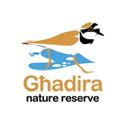
CONNECTING WITH NATURE LEADS TO A HEALTHIER LIFESTYLE! Which is why BirdLife Malta is organising two summer courses for a total of 40 children (20 in each course) to join us and DISCOVER, LEARN and have lots of FUN.



YES!
20 Nature Guardians (aged 7-11)
2 courses to choose from (3-31 Jul & 2 Aug-6 Sep with a break for Sta Marija week)
13 sessions (Monday, Wednesday, Friday 5pm-8pm)


4 nature reserves to visit Countless activities to carry out together

ONLY 20 PLACEMENTS AVAILABLE - BOOK NOW TO AVOID DISAPPOINTMENT

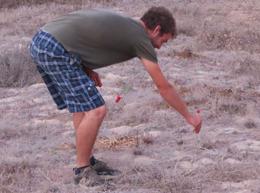
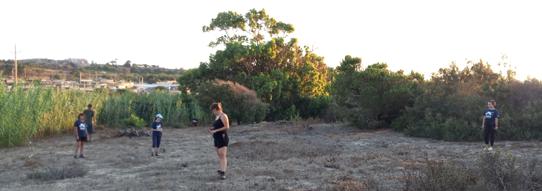
The remnant coastal sand dune at Għadira Nature Reserve is one of a handful of sites where the Burrowing Sand Cricket (Grillu tar-Ramel) Brachytrupes megacephalus still thrives in Malta. The species range is limited to the central to western Mediterranean and it is protected under the European Habitats Directive. The European Environment Agency gives its conservation status as ‘unfavourably bad’ with a downward trend.
The main threats facing this species include urbanisation, habitat disturbance and destruction, storm surge, sea-level rise, and predation by rats and cats. If this insect is to survive, it is vital that sites where it still occurs are given due protection, and its population status updated.
The Sand Cricket has long been recorded regularly at Għadira but recently its number increased, an increase which coincided with the recent restoration of the sand dune. The nocturnal crickets are mostly active from dusk to dawn, with a flurry of activity just before sunrise. They make shallow semi-circular depressions –known as ‘acoustic chambers’ – at the entrance of their tunnel dwelling. The acoustic chamber echoes the insect’s stridulation. At first light the insect can be observed pushing sand out of the burrow in small bursts, occasionally also cutting and carrying pieces of vegetation underground.

In summer 2022 BirdLife Malta carried out a monitoring survey, in collaboration with Prof. Louis F. Cassar (University of Malta), to evaluate the cricket’s population. The study was conducted once weekly over 11 weeks (15 Jul – 23 Sep), with observations made from 5.45am to 7am.
The study site was the sand dune (ca 2,000m2), which includes areas of bare sand as well as areas under tree canopy. Four to
six observers took part on each observation date. The observer would stay motionless for 10 minutes at their post and log all active burrows within the surrounding 10m2. The observer then marks the burrows with coloured flags and moves to another area.
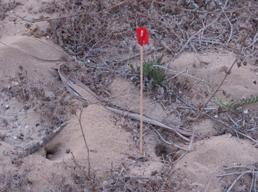
Differently-coloured marker flags were used for different weeks, following which their GPS coordinates were taken and plotted onto a GIS map. Heat maps were generated to show the crickets’ spatial distribution from week to week. In this way, the abundance of crickets over the whole area was calculated.
At the start of the study period, a total of 40 active burrows were noted, reaching a maximum of 77 in mid-August, then declining to less than five by late September. The cricket showed a strong preference for areas with clear sand, with very few burrows found under tree cover.
It has been decided to repeat the survey annually as this will help us understand better the biology and habits of this rare species. In this way we can adapt habitat management to help increase its population at the reserve and beyond.

Summer is not usually associated with hiking in Malta, and just the thought can make one sweat. Neither are the Maltese Islands known for having many breeding birds, mostly due the our small size. But one group of birds thrives in the last relatively undisturbed corners of the islands. These birds are best enjoyed on those calm balmy summer nights!
This walk takes us along the limestone cliffs starting at Miġra l-Ferħa on the west coast of Malta. It is only half an hour or so each way but you can make it as long as you want; for those not confident to walk along rough coastal tracks in the dark, the parking area or any spot along the trail will do just fine too.



Arrive an hour or so before sunset, or even a bit earlier, and walk down the natural gorge to the sea level. The spot makes for great snorkelling for good swimmers. The cliff continues underwater into the deep blue, studded with Bristle Worms and Starfish, as well as several underwater caves.
Back on land, listen for singing Blue Rock-thrush and Greater Short-toed Lark as you walk east along the clifftop path bordered by plants such as Mediterranean Thyme, while the endemic Maltese Salt Tree and Maltese Rock-centaury cling to the cliff

edges. As you approach Ras id-Dawwara, also known as Il-Qaws, bathed in the last rays of the sun, take in the stunning sea cave called Għar idDwieb. As you enjoy the sunset, look out at sea for the night’s protagonist as it skims the waves: Scopoli’s Shearwaters!
As the name implies, shearwaters fly (unlike gulls) very close to the sea surface, gliding on outstretched wings. Find a comfortable rock to sit on and wait for darkness. Concert times are variable, but start about 45 minutes after sunset. That is when Scopoli’s Shearwaters approach their cliff-site nests and greet each other with eerie calls that have fascinated Mediterranean civilisations for centuries. Multiple birds calling at the same time, reverberating against the cliffs make for quite the natural experience. Depending on the moon phase and time of year, the symphony might go on for hours, even all night, so head back slowly once you’ve had your fill.
Seabirds enter their burrows in the cover of darkness and avoid moonlit nights, so don’t pick a night with a full moon. Highest calling activity occurs from March to August but vary a lot and some nights are silent.
Seabirds are already under various threats, so remember two very important things when visiting: (1) at all times during your walk use a torch with red light (sold at most outdoors shops), since this disturbs less than white light, (2) Leave no litter behind, even organic, since litter leads to rat proliferation, which also feed on shearwater eggs and chicks.
Shearwaters breed along most of the Maltese coastline where this is dominated by cliffs; in Gozo, Ta’ Ċenċ and Dwejra are great alternatives. For those who need to make the last bus home, shearwaters can even be heard, albeit more distantly, from Xlendi promenade or the Blue Grotto viewpoint.
See if you can identify the different Shearwaters!

Want to know what to listen out for before you go? Check out the recording here:
Can you make out the Yelkouan Shearwaters calling in between the Scopoli’s Shearwaters? Yelkouan Shearwaters breed earlier than their larger relatives and by summer have very low calling activity.


 As dusk turns into night, shearwaters (here showing Yelkouan Shearwaters) can be spotted in the fading light flying close to the sea surface and approaching land. Once complete darkness falls, the patient listener can enjoy their calls from the cliffs
Marc Schruoffeneger
A Scopoli’s Shearwater catches the last sun rays on outstretched wings as it joins other shearwaters to wait for darkness
Paulo Lago
Two endemic plant species, the Maltese Salt Tree and the Maltese Rock-centaury, are among the plants that grow on the steep coastal cliffs
Martin Austad
WORDS Martin Austad Seabird Research Coordinator
Victor Falzon
As dusk turns into night, shearwaters (here showing Yelkouan Shearwaters) can be spotted in the fading light flying close to the sea surface and approaching land. Once complete darkness falls, the patient listener can enjoy their calls from the cliffs
Marc Schruoffeneger
A Scopoli’s Shearwater catches the last sun rays on outstretched wings as it joins other shearwaters to wait for darkness
Paulo Lago
Two endemic plant species, the Maltese Salt Tree and the Maltese Rock-centaury, are among the plants that grow on the steep coastal cliffs
Martin Austad
WORDS Martin Austad Seabird Research Coordinator
Victor Falzon
15 Mar 2023 The education and conservation teams participated in festAmbjent at the Junior College where we delivered an informative workshop on BirdLife Malta's conservation efforts. A stand was available in the college foyer, where attendees learned more about our activities and Maltese birds. The workshop was a success, and many young people expressed interest in biodiversity conservation.
24 Mar 2023 British naturalist and broadcaster David Lindo, known as The Urban Birder, gave a presentation about his early years as a young birder and shared some of the amazing birding experiences he had in urban environments around the world. The event at Salina Nature Reserve was attended by bird enthusiasts and nature lovers.
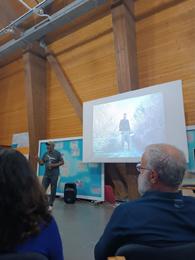
15 Apr 2023 Our LIFE PanPuffinus! shearwater colony walk at Rdum id-Delli was a success. Participants enjoyed Short-toed Larks, Blue Rock-thrushes and seabirds, as well as a beautiful rainbow and sunset. We are grateful to Majjistral Nature & History Park for hosting the event, and thank everyone who joined.
28 Mar 2023 The Academy of Givers hosted the second edition of the "For Impact Event and Fair" at Salini Resort which gave the public and students an opportunity to learn about social and environmental issues, connect with organisations, and participate in workshops and panel discussions. BirdLife Malta showcased our conservation and education initiatives.


8 Apr 2023 At Foresta 2000 we hosted 112 kids and their parents for this year’s Easter EggCitement event. Participants searched for chocolate eggs and solved various fun tasks. After the egg hunt, the guests went to Għadira Nature Reserve for birdwatching and educational games, followed by face painting.

21 Apr 2023 Participants joined our LIFE PanPuffinus! project team to enjoy a beautiful spring evening at Dwejra in Gozo, witnessing a stunning sunset from the rooftop of Dwejra Tower. The highlight was listening to the calls of Scopoli's Shearwaters under a starry sky, as pairs reunited and prepared for nesting. We also discussed the conservation of shearwaters and encouraged public involvement in protecting their habitats by reducing litter in coastal areas. Thanks Din l-Art Ħelwa for hosting us.


23 Apr 2023 Our youth hike on Kemmuna proved to be an exciting and educational experience. Accompanied by group leaders, participants focused on birdwatching and conservation efforts, visiting the bird ringing station and observing various birds like Common Hoopoe and European Bee-eaters. The event formed part of the It’s Time Erasmus+ project which aims to create a BirdLife International Youth Council.

29 Apr 2023 The BirdLife Malta Events & Activities Group organised a birdwatching trip to the Pantani Cuba & Longarini Nature Reserve, an important wetland for migrating birds in southeast Sicily. The reserve is owned by a German foundation focused on securing and protecting migratory bird stopover sites. Paolo Galasso, guide and conservation biologist, highlighted the restoration efforts undertaken by the foundation to create suitable habitats for existing species, including the endangered Marbled Duck. We also explored the blooming meadows in the Pantano Cuba section and learned about the historical connections between Pachino and Maltese families through a guided tour by Marcel Zammit Marmara.
6 May 2023 Our Blooming Minds team participated in the international Darkness into Light event in Malta for the first time, dedicated to raising awareness and preventing suicidal behaviour and mental disorders. We walked from the Triton Fountain to the Sliema Chalet along

the coast, witnessing the breathtaking arrival of dawn. The event concluded with Yoga Asanas, providing an opportunity to connect with others, have meaningful conversations, and embrace the beauty of the sunrise.
7 May 2023 Our Klabb Ħuttaf members had an unforgettable experience during a night walk at Foresta 2000, immersing themselves in the mysteries of nature as the sun set. They enjoyed engaging stories about local birds, played games to learn about echolocation, and used bat detectors to spot bats and chameleons. The evening concluded with a late picnic by torchlight.

14 May 2023 At Science in the Citadel in Gozo, we showcased the LIFE PanPuffinus! project and focused on seabirds that breed in Malta. Our stand provided information about seabirds and the threats they face, and we engaged children in educational puzzles, memory games and videos of seabirds in their natural habitats. We had over 450 visitors and we were inspired by the public's interest in biodiversity conservation and their willingness to contribute to conservation efforts. We also celebrated the European Maritime Day In My Country campaign, further stressing the importance of marine conservation.
17 Jun 2023
Salina Nature Reserve will host Above & Below Salina: A natural and cultural experience being organised by the Superintendence of Cultural Heritage in collaboration with Heritage Malta and BirdLife Malta as part of the European Archaeology Days. The free event, running from 10am to 4pm, is open to the public and will include activities for children.
5 Aug 2023
Dinosaurs were such fascinating creatures, so we’re having a Dinosaur Day for our Klabb Ħuttaf members - a day full of dinosaurs, smiles, learning... and nature! We promise you a very enjoyable time under the trees at our Simar Nature Reserve. Come and explore the connections between birds and dinosaurs through our fun crafts and activities.
17-18 Jun 2023
Join BirdLife Malta at the Upper Barrakka Gardens in Valletta for Eco Festival. Visit our stand to discover more about our work, learn fascinating facts about birds, play some fun games, and receive our special gifts. Don't miss this fantastic opportunity to engage with nature and support our cause. We can't wait to see you there!

11 Aug 2023
Calling youths aged 14-26 to hoin us at Salina Nature Reserve for an exciting adventure. Discover the fascinating world of Scopoli's Shearwaters as we embark on a quest to find our destination for a clean-up and walk to listen to the eerie calls of these magnificent birds. Visit our website and secure your spot today.

14-16 Jul 2023
BirdLife Malta will participate for the first time in this year’s Global Birdfair at Oakham’s Rutland Showground (UK), an annual event for naturalists. This is the second edition of this event which has replaced the British Birdwatching Fair.
Want to help us continue our work?
Join at http://bit.ly/joinBLM
Donate at http://bit.ly/donate-to-birdlifemalta
Support at http://bit.ly/Becomeasupporter
Volunteer at http://bit.ly/volunteerwithBLM
Want to join an event?
Get more details at http://bit.ly/joinanevent or email events@birdlifemalta.org or call +356 2134 7646
BirdLife Malta’s LIFE PanPuffinus! project team is monitoring this year’s breeding season of Yelkouan Shearwaters. Now that all chicks have hatched, fieldwork becomes intense and nights can be short. Yelkouans fly to their cliffside burrows at night, and it’s the only time our biologists can study them. The team waits in darkness for the parents to land. They check their overall health by weighing them, and monitor the population through ringing and observation. The team is also ensuring the birds’ safety on land by controlling rodent predation using camera traps, baiting and mechanical traps.
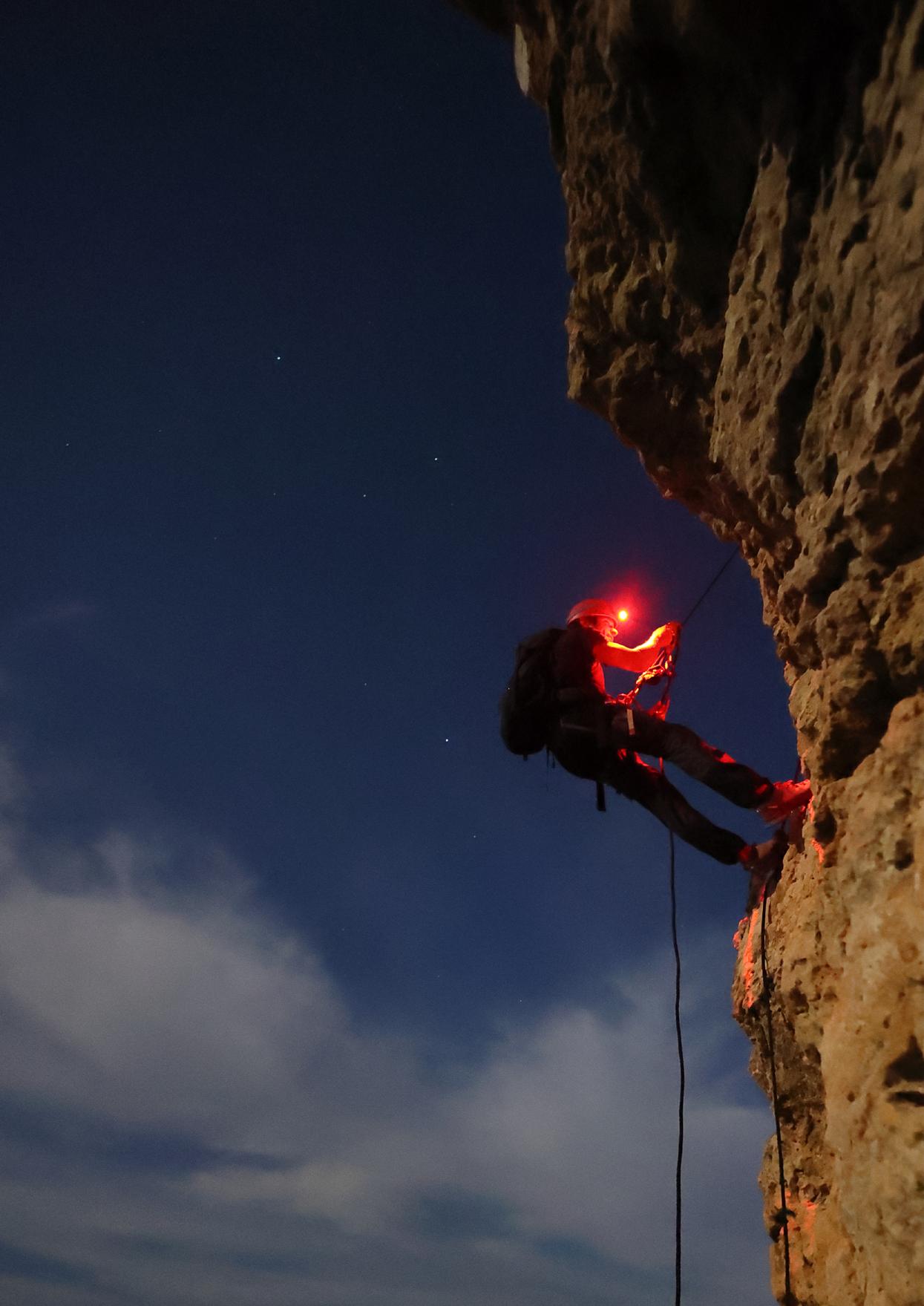 Benjamin Metzger
Benjamin Metzger